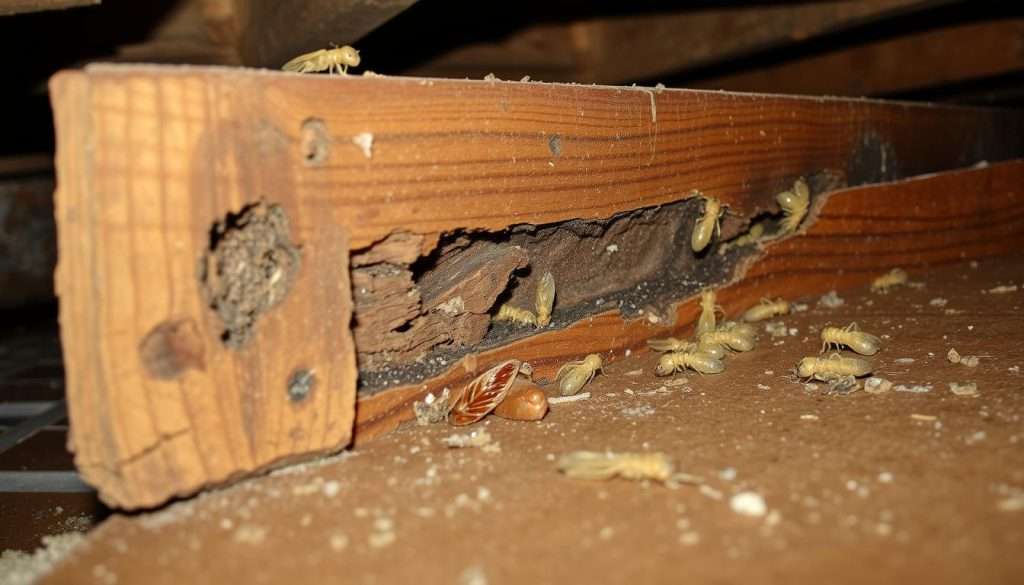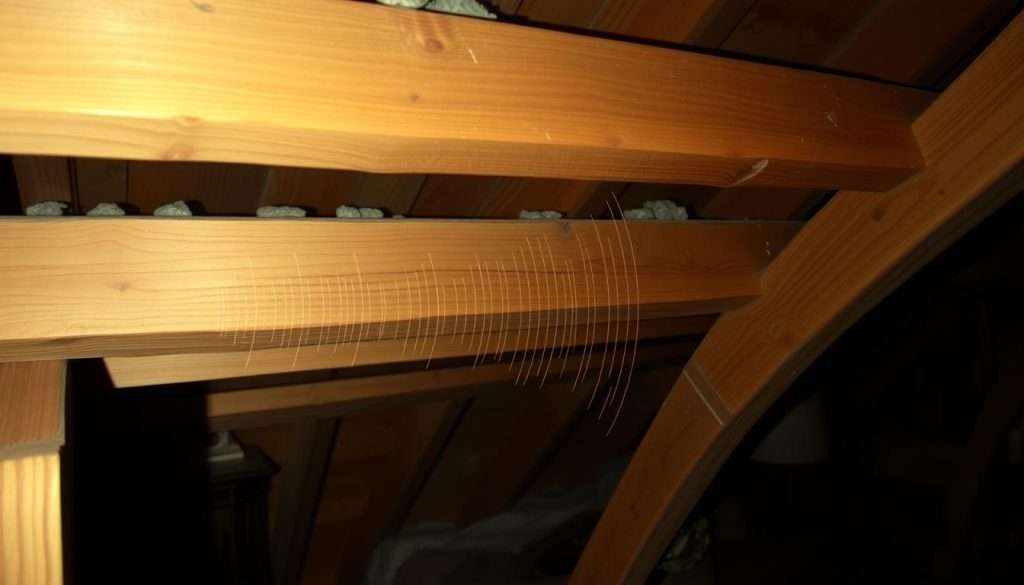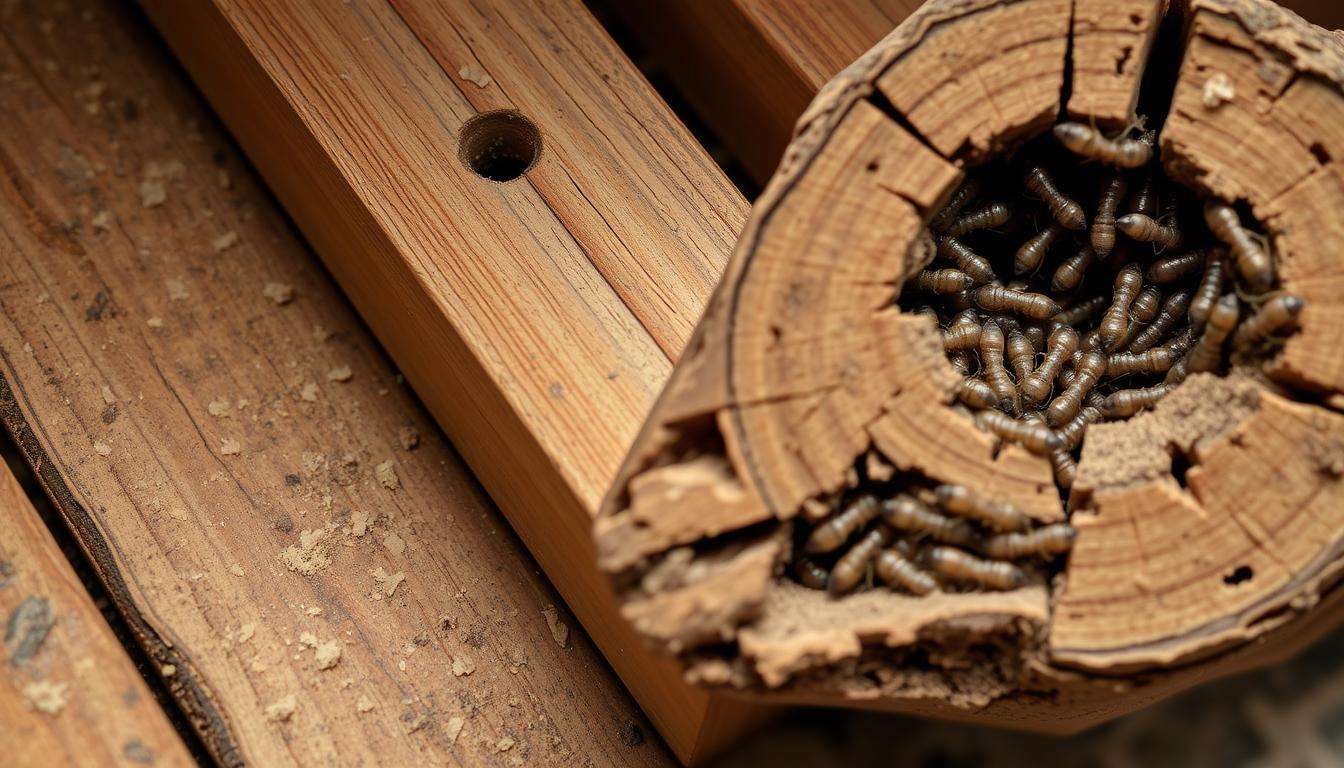Termites are sneaky pests that can damage homes a lot without anyone noticing for years. In the U.S., they cost homeowners over $5 billion each year. This is more than many natural disasters.
It’s very important to find termites early to avoid expensive fixes. Look for mud tubes, droppings, and wood damage. Knowing the signs can help you act fast. For more info, check out this resource.
Key Takeaways
- Early detection can prevent extensive property damage.
- Termites cause over $5 billion in damage annually in the U.S.
- Look for mud tubes and wood damage to identify infestations.
- Understanding termite behavior helps in dealing with infestations.
- Routine maintenance can help prevent termite damage.
Understanding Termites and Their Behavior
To fight termite problems, knowing about the different types and their habits is key. These pests live in many places and can harm your home in big ways.
Types of Termites
There are three main types of termites, each with its own habits and homes. Knowing about them helps you prevent and treat infestations.
- Subterranean Termites: These are the most common in the U.S. They love moist places, like near your home’s foundation. They use mud tubes to get from their underground homes to your wood.
- Drywood Termites: These termites live in the wood they eat and don’t need soil. They’re often in furniture or attics. They can cause big problems before you even notice them.
- Dampwood Termites: These termites like damp or rotting wood. They can damage wet structures.
How Termites Cause Damage
Termites damage homes in different ways. They all eat cellulose, like wood, paper, and even wiring. If not stopped, they can ruin your home’s structure.
- Subterranean termites can make lots of swarmers, leading to big colonies that keep looking for food.
- They love damp places, making wooden parts of your home weak.
- Drywood termites may not make as many swarmers, but they can still damage furniture and beams because their nests are hidden.
Seeing mud tubes means termites are there or were there. Check for them often. Using systems like the Sentricon Termite Prevention System can keep termites away for good.
What Are Signs of Termites
Spotting termites early is key to avoiding big problems. Termites damage over $5 billion worth of property each year in the U.S. Knowing the signs can save you from expensive fixes and health issues.
Importance of Early Detection
Finding termite signs early helps protect your home. Look out for:
- Frass or droppings left behind by drywood termites
- Shed wings around windows and doors
- Mud tubes leading to food sources
- Doors or windows hard to open due to wood damage
Different termites show different signs. For example, Formosan termites swarm at dusk, leaving wing fragments. Subterranean termites make mud tubes on walls. Catching these signs early helps prevent damage.

Knowing about termites can lower your risk. They can live undetected for years, causing damage. Don’t wait for big signs; being proactive is better for your home.
Identifying Termite Damage
Spotting termite damage early is key to keeping your home safe. Homeowners need to know what to look for to stop problems before they get worse. Termite damage has clear signs that, if found early, can save a lot of time and money.
Visual Signs of Structural Damage
Termites can cause a lot of harm to your home’s structure. Knowing these signs can help a lot. Here are some things to watch out for:
- Discolored or Drooping Drywall: This could mean termites are causing moisture issues, weakening your walls.
- Wood Damage: If wood sounds hollow when tapped, termites might be eating away at it.
- Bubbling Paint: Bubbling paint looks like water damage but could mean termites are at work inside your walls.
Wood Damage Characteristics
It’s important to know how termites damage wood. They leave specific marks:
- Small Holes and Channels: Termites like Coptotermes make thin channels in wood.
- Deep Cuts: Schedorhinotermes termites make wider, deeper cuts in wood.
- Softness in Trim and Frames: If skirting boards, door frames, or window frames feel soft, termites might be there.
Knowing these signs helps you act fast to avoid big damage. Remember, termite damage can go unnoticed for years, leading to big problems and expensive fixes. Regular checks and knowing these signs are key to protecting your home.
| Type of Damage | Indicator | Implications |
|---|---|---|
| Discoloration | Drooping drywall | Weak structural integrity |
| Wood Damage | Hollow sounds when tapped | Extensive tunneling, increased repair costs |
| Paint Damage | Bubbling paint | Potential water damage, hidden termite activity |
| Trim Damage | Softness in wood | Signs of active infestation needing immediate attention |
Physical Signs Indicating Termite Activity
It’s important for homeowners to know the signs of termite activity. Finding mud tubes and termite swarms are key signs. These signs can help prevent costly damage, which costs Americans over $5 billion each year.
Finding Mud Tubes
Look for signs of termite activity by checking for mud tubes. These tubes are made of mud, saliva, and feces. They help termites move around your home safely.
They might be hard to see, which can delay action. It’s crucial to check your home’s edges often. This helps catch any problems early.
Recognizing Termite Swarms
Termite swarms happen when mature colonies release winged termites. Termite swarms are when these insects fly around your home. Seeing them means termites are coming into your space.
If you see swarmers, call a pest control expert right away. They can check the situation and stop damage before it starts.
Termite Droppings: What to Look For
Finding termite droppings is key to spotting an infestation at home. These droppings, or frass, show that drywood termites are around. Knowing about frass helps homeowners spot signs and act fast. It’s also important to tell frass apart from sawdust for good pest control.
Understanding Terminology: Frass vs. Sawdust
Termite droppings, or frass, are small pellets, about 1mm long. They form small mounds near tiny holes. Unlike sawdust, frass shows termites are present. Here’s a quick guide to help you tell them apart:
| Characteristic | Frass | Sawdust |
|---|---|---|
| Appearance | Small, six-sided pellets | Coarse, larger particles |
| Source | Termite feeding activity | Wood degradation from various sources |
| Location | Near termite entry points | Generally throughout structures |
Learning to tell these apart can stop more damage. If you think termites are around, look for droppings. Also, get a pro’s help, as insurance often doesn’t cover termite damage. For more on managing droppings, check out this guide.
Auditory Clues of Termite Infestation
Finding termites early is key to saving your home. One way to spot them is by listening. You might hear clicking or rustling as they eat wood.
Noises Coming from Walls
Look for sounds from walls to find termites. Soldier termites tap on wood to warn others. If you hear this, it’s a big problem.
- Signs of Active Infestation: Sounds from walls mean termites are damaging your home.
- The Importance of Listening: Paying attention to sounds can help you catch termites early.

Knowing these sounds helps you act fast. Spotting them early can save you from costly repairs.
Visual Indicators: Wings and Nests
Spotting signs of termite activity early is key. Look out for shed wings and nests. These are big clues of termite problems. We’ll show you how to spot them.
Shed Wings Around Your Home
Shed termite wings mean a big termite problem. After they fly, they leave their wings behind. You might see them near windows or your home’s base.
It’s important to tell termite wings from flying ant wings. Termites have straight antennae and wings of the same length. Ants have elbowed antennae and longer front wings.
If you see these wings, act fast. It’s the best way to stop more damage and keep your home safe.
Identifying Termite Nests
Finding termite nests is about looking for certain signs. Identifying termite nests means spotting mud tubes. These tubes help termites move around.
Seeing swarmers inside means there’s a nest nearby. Here’s how to find them:
- Look for tunnel-like damage in wood.
- Check damp places for termites.
- Find swarmers near lights, as they’re drawn to them.
Spotting these signs is crucial for homeowners. Acting quickly when you see termites or nests can save your home from big damage.
Conclusion
Homeowners need to watch out for termites. Knowing about termites is key. Finding them early can save your home and money.
Termites can cause a lot of damage. They can harm your home for up to $40 billion each year. This shows why you must be careful.
Look for signs like mud tubes or wings. These signs mean termites are around. Checking your home often can stop big problems.
Termites can grow fast. They can become a problem in just three to five years. So, checking your home often is very important.
If you see signs of termites, call a professional right away. Quick action can protect your home. It keeps termites from damaging your house without you knowing.
